Geek Articles
MTF Results for Recent Sigma Art Lenses
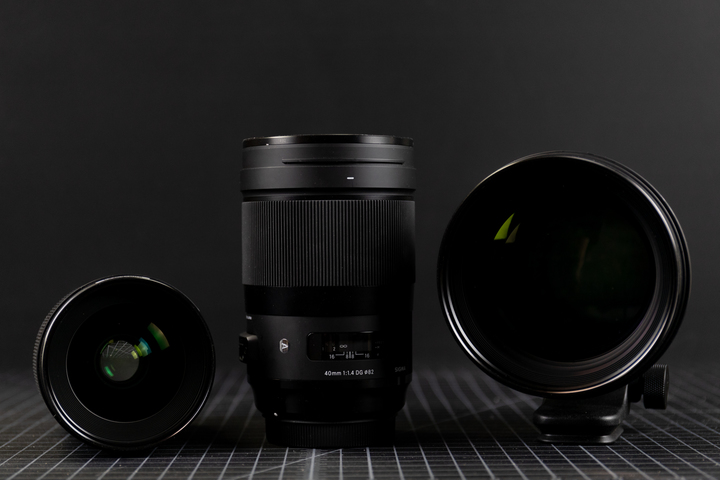
And you may find yourself in a shotgun shack.
And you may find yourself in another part of the world.
And you may find yourself behind the wheel of a large automobile.
And you may find yourself in a beautiful house.
And you may ask yourself, well, what should I shoot with?
A number of people have noticed I haven’t been publishing MTF results for new lenses lately. There’s a lot of reasons for that, but all primarily come down to I’m doing too much other stuff. For a year, my priority has been improving our in-house testing methods; developing the Rapid MTF tests has taken several thousand hours (not all mine, but it seems that way sometimes). Introduction of new mounts (R, Z, SL) each means making modifications to our test bench, etc. etc.
There were also discussions with some other websites to host our data and make it more obtainable and organized. Those faded out, but for a while, I was hoping things would get automated, and I wouldn’t have to write these posts anymore. (And I’m the guy who coined the term HINAP: Hope Is Not A Plan. So yet again, my hope was a downpayment on inevitable disappointment.)
We still run the tests; I just haven’t had the time to do the write-ups. I’m going to try to get those out reasonably quickly by grouping them. Today we’ll post the several Sigma Art lenses that have been released and tested over the last few months.
My Expectations are Simple
I make no efforts to hide the fact that I love Sigma’s attitude; it’s refreshing. Every lens made by anyone balances three things: price, size, and image quality. Sigma has made their attitude clear; size can be damned; we’re going to make reasonably priced lenses with amazing image quality. If they’re huge, they’re huge. That’s what I expect from all the Art primes.
In these days when most manufacturers have replaced their marketing department with a Poet Laureate blowing more smoke than a California wildfire, Sigma goes with the three-step ‘how to build confidence’ model of marketing:
- Tell ’em what you’re going to do.
- Do it.
- Show them that you’ve done it.
Today I’m going to show you if they’ve done it. We’ll look at three newer Sigma Art Models: the 28mm f1.4 DG HSM Art; 40mm f/1.4 DG HSM, and 105mm f/1.4 DG HSM Art lenses. I’m going to keep it relatively quick and straightforward: MTF charts, and a couple of comparisons for each lens. I’m not going to show variance graphs; people abuse them, and the variance for all of these was very low.
Sigma 105mm f/1.4 DG HSM
At $1600 it’s quite a bit cheaper than the other 105mm f1.4 lens (the Nikkor 105mm f/1.4 E ED), but at 3.5 pounds it’s pretty huge. It’s heavier than the Sigma 135mm f/1.8 DG HSM Art. So it had better be good.
It is good. It is very, very good. I particularly draw your attention to the purple line (50 lp/mm) which correlates with fine detail on a high-resolution camera. We like for that to be over 0.5, and the Sigma is 0.7. That is truly exceptional, and the lens maintains sharpness well to the edge of the image with little astigmatism.

Lensrentals.com, 2019
The obvious comparison is to the Nikon 105mm f/1.4, and the Sigma looks just spectacular here.
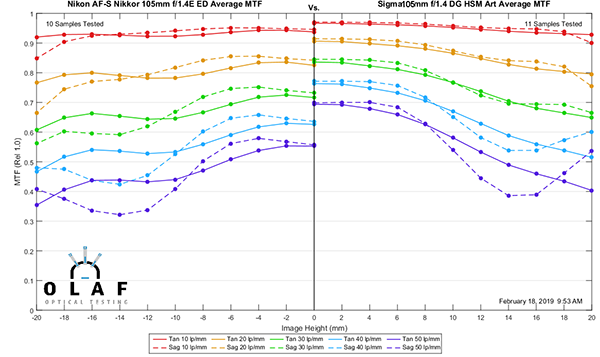
Lensrentals.com, 2019
The Zeiss 100mm f/2 Makro-Planar should be an unfair comparison; the Zeiss is being tested at f/2 which should give it a big advantage. Sigma doesn’t care, though; from a resolution standpoint, it’s clearly superior at f/1.4 to the Zeiss at f/2.
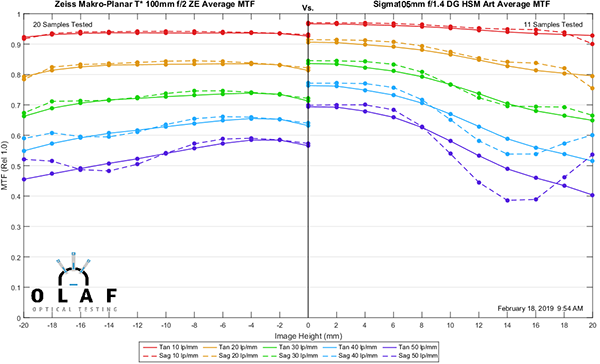
Lensrentals.com, 2019
I’m not trying to tell you that you need a 3.5 pound 105mm f/1.4 lens. I’m just telling you that if you need a 105mm f1.4 lens, the Sigma Sumo Wrestler is the sharpest one.
Sigma 40mm f/1.4 DG HSM
I’m not sure if 40mm is the new 35mm or the new 50mm. The Sigma 40mm is (compared to the 105mm at least) a fairly light 2.5 pounds. Can they still do laser sharp with a pound less glass in this thing? Yeah, pretty much.
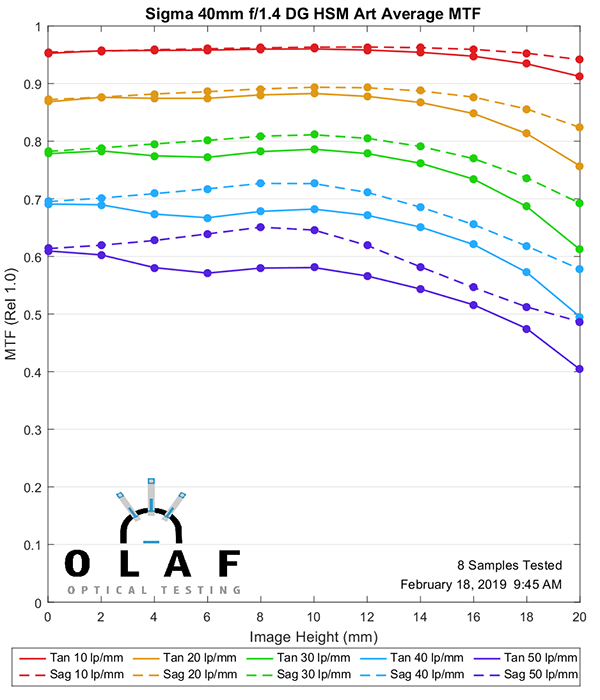
Lensrentals.com, 2019
Of course, the MTF is not quite as impressive as the 105mm, because telephoto lenses are generally sharper than mid-range lenses. So let’s compare it to some similar focal lengths. My first comparison isn’t really fair; the Tamron 45mm f1.8 Di VC is one of my favorite bargain lenses, costing about 1/3 of what the Art does. The Tamron is an excellent lens, and I put this comparison up just to show how excellent the Sigma is.
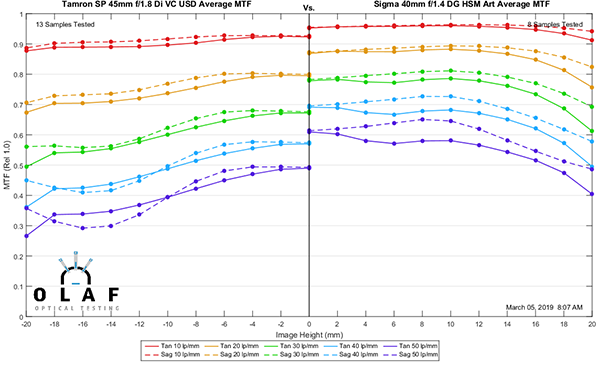
Lensrentals.com, 2019
Let’s move over to something more in the same financial class. I think comparisons to the Sigma 35mm and 50mm f/1.4 Art lenses are appropriate; unless you need to collect the whole set, a lot of people will be picking one from among these.
We’ll start with comparing the Sigma 35mm f1.4 Art to the 40mm. (For those of you who don’t recall, the Sigma 35mm Art is our current mid-range resolution MTF champion. If you own a great 35mm prime lens, it’s MTF is nearly as good as the Sigma 35mm Art.) Which means the Sigma 40mm is at least as good in the center, and better away from the center than any of the 35mm f1.4 lenses we’ve tested.
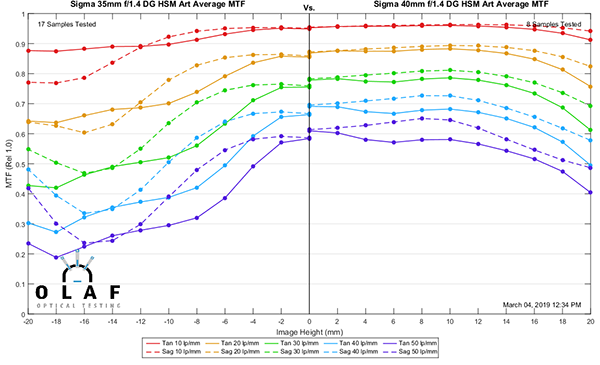
Lensrentals.com, 2019
We’ll do the other side of the bracket now, comparing the 40mm to the Sigma 50mm f1.4 Art.
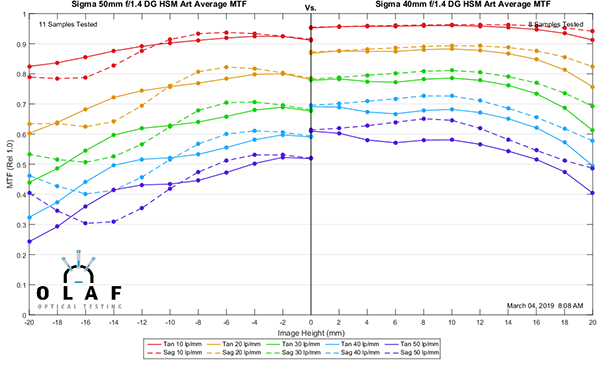
Lensrentals.com, 2019
OK, let’s see if the Sigma can punch out of its price class. Here’s the Sigma 40mm compared to the much pricier and equally heavy Zeiss 55mm Otus, just for fun. Color me impressed.
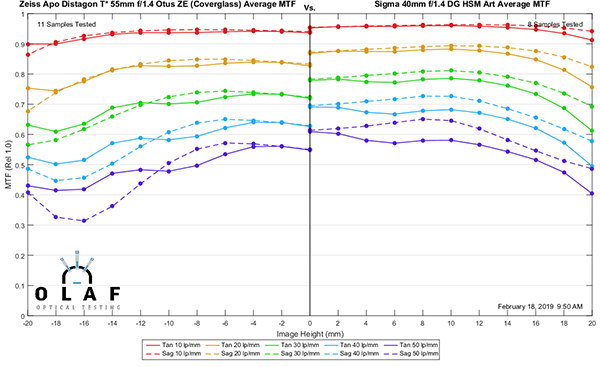
Lensrentals.com, 2019
Sigma 28mm f1.4 DG HSM
The 28mm f/1.4 slides neatly into the slot between the 24mm and 35mm Art lenses. (You didn’t know that was a slot? Cinematographers do, and that’s probably some of the reason Sigma made these lenses.) Like the other two, the MTF is excellent. The other nice thing is the 28mm is a LOT smaller and lighter than the others. So, can Sigma do sharp without huge? Yes. Yes, they can.
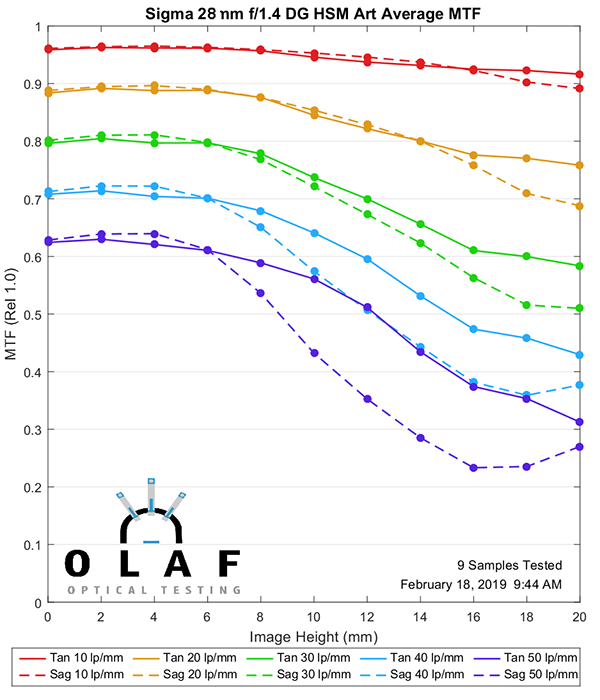
Lensrentals.com, 2019
You can scroll up a bit and see that the 28mm Art definitely has a better MTF than the 35mm Art. Let’s compare it to the 24mm side-by-side. The 24mm is not the best of the Art primes, and the difference between it and the new 28mm is dramatic.
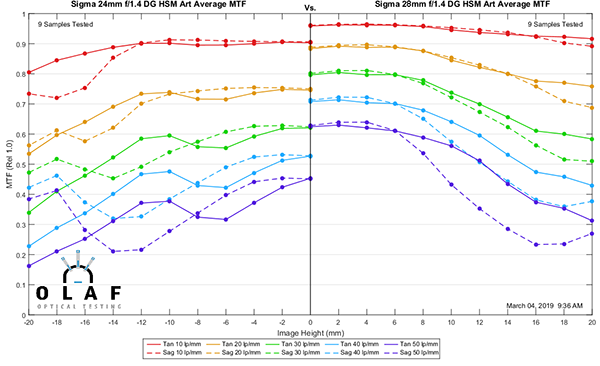
Lensrentals.com, 2019
Let’s go straight to the mountaintop, and compare the Zeiss Otus 28mm f1.4 to the new Sigma. This comparison surprised even me. The Sigma is sharper in the center, although things even up away from the center. But you could buy all three of the latest Sigma’s for the price of the Otus 28mm.
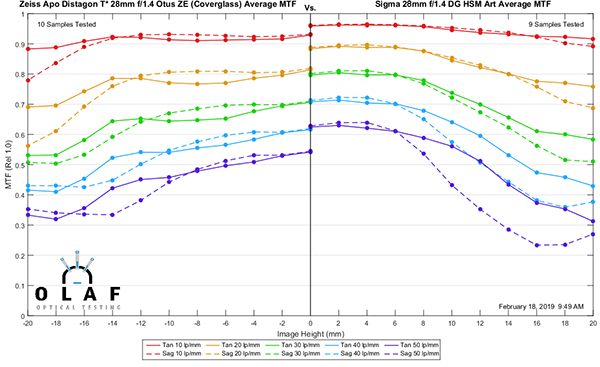
Lensrentals.com, 2019
Conclusions:
First, a reminder: this has been an MTF test. It is only an MTF test. Had this been an actual lens review I’d have talked about other stuff, but it’s not, and I don’t. I test lenses, and I tell you about the test results. If you’re into bourgeois concepts, like sharpness, then these are certainly worth further investigation. You have to decide if it ‘takes your creativity to a new level’ or whatever.
But as far as MTF tests go, Sigma Art lenses set the bar high back when the first ones were released. These new ones have raised the bar even higher. I shouldn’t be surprised; Sigma did exactly what they said they would do.
I think one of the major reasons for the new releases was to give more focal length selection for videography. The fact that we could get video versions of these as soon as (and in one case before) the photo lenses were released tends to support that.
But if you are considering adding an Art Prime to your photo collection, from a resolution standpoint, I’d take a very serious look at these three. Yep, they are big and heavy. Nope, no image stabilization. But damn, they outresolve just about anything else you can buy.
Same as it ever was.
Same as it ever was.
Same. As. It. Ever. Was.
Roger Cicala and Aaron Closz
Lensrentals.com
March, 2019
Author: Roger Cicala
I’m Roger and I am the founder of Lensrentals.com. Hailed as one of the optic nerds here, I enjoy shooting collimated light through 30X microscope objectives in my spare time. When I do take real pictures I like using something different: a Medium format, or Pentax K1, or a Sony RX1R.
-
Tuolumne
-
Ed Hassell
-
Vladimir Gorbunov
-
bdbender4
-
Barbu Mateescu
-
Roger Cicala
-
Roger Cicala
-
Ed Hassell
-
Vladimir Gorbunov
-
Roger Cicala
-
Roger Cicala
-
Roger Cicala
-
DrJon
-
Vladimir Gorbunov
-
Vladimir Gorbunov
-
Ryan Stone
-
Ed Hassell
-
Barbu Mateescu
-
Roger Cicala
-
Roger Cicala
-
Barbu Mateescu
-
Tuolumne
-
DrJon
-
Kevin
-
Roger Cicala
-
Sean Tomlinson
-
Sean Tomlinson
-
Roger Cicala
-
Barbu Mateescu
-
Wade Tregaskis
